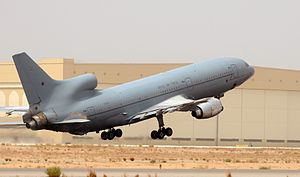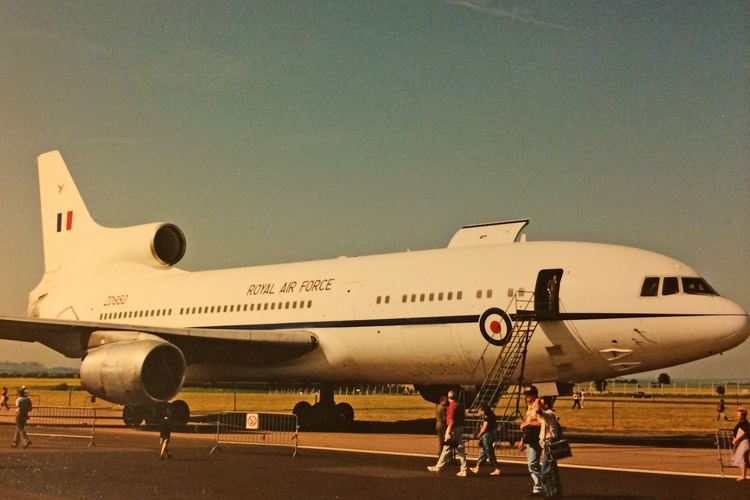Length 50 m | Wingspan 50 m | |
 | ||
The Lockheed TriStar was an air-to-air tanker and transport aircraft in service with the Royal Air Force (RAF). All were converted civilian Lockheed L-1011-500 TriStar airliners—previously operated by British Airways and Pan American World Airways—and entered service with the RAF in 1984.
Contents

The converted aircraft were purchased following the Falklands War, after a requirement for additional air-to-air refuelling operations had been identified. Of the nine in service, two were tankers (K1) with passenger space and also limited space for cargo loaded aft of the main deck; three were solely transport aircraft (C2); and the remaining four (KC1) could be used for either of the two roles. The TriStars formed the air-to-air refuelling fleet of the RAF until replaced by the Airbus A330 MRTT under the Future Strategic Tanker Aircraft (FSTA) programme.

The TriStar fleet was operated by No. 216 Squadron of RAF Brize Norton in Oxfordshire. 216 Squadron was officially disbanded on 20 March 2014 and flew its last sorties with the TriStar on 24 March 2014.

Design and development

The Royal Air Force operated nine L-1011-500s TriStars, six ex-British Airways and three ex-Pan Am. The TriStars were bought in the immediate aftermath of the Falklands War to bolster the long range capability of the RAF in the transport and tanker roles, as the demands of refuelling Hercules supporting forces stationed in the Falklands was rapidly using up the fatigue life of the RAF's Handley Page Victor tankers. A requirement for at least four wide-bodied tanker/transports was drawn up. At the same time, British Airways wished to dispose of its Lockheed L-1011-500 aircraft, and so put in a joint bid with Marshall Aerospace to supply six TriStars. The initial order for the ex-British Airways TriStars was placed on 14 December 1982; the three ex-Pan Am aircraft were purchased in 1984. All of the aircraft served with No. 216 Squadron, based at RAF Brize Norton.
Marshall Aerospace performed the conversion of the TriStars. Two of the aircraft were passenger/tanker aircraft designated TriStar K1s. Another four could operate as either tankers or passenger/cargo aircraft - these are KC1s. Three were pure passenger aircraft; two TriStar C2 and the solitary TriStar C2A. The C2A differed from the C2s in having some military avionics and a new interior.
The RAF's TriStars were subject to progressive updating, including the fitting of flight deck armour and Directional Infrared Counter Measures to protect against ground fire when flying into Iraq. The aircraft were to be fitted with an updated cockpit, but this was abandoned due to the upcoming out-of-service-date.
The TriStar was expected to remain in service with the RAF until the end of the 2010s, when it was scheduled to be replaced by the Airbus A330 MRTT under the Future Strategic Tanker Aircraft (FSTA) programme. However, the date was brought forward to 2014 under the Strategic Defence and Security Review of 2010. The Airtanker consortium, led by EADS, won the FSTA contract in January 2004. During doubts over the FSTA program, Marshall Aerospace offered to buy and convert some of the large number of surplus commercial TriStars as tankers, but this was rejected.
Operational history
The aircraft saw service in many conflicts. Two were deployed to King Khalid International Airport, near Riyadh in Saudi Arabia during the 1991 Gulf War as tankers, with the rest used for transport between the Persian Gulf and United Kingdom. The two aircraft deployed received nose art naming them Pinky and Perky. During the 1999 Kosovo War, TriStars deployed to Ancona in Italy, again as tankers, with four aircraft involved. TriStars joined VC10s in the air-to-air refuelling role for Operation Veritas (Afghanistan), during which they provided aerial-refuelling for US Navy aircraft. The RAF deployed four TriStars during Operation Telic to Bahrain.
TriStar air-to-air refuelling aircraft supported the British air strikes on Libya on 19–20 March 2011 as part of the coalition operations to enforce UN Resolution 1973.
Variants
Operators
Specifications (TriStar K1)
Data from The International Directory of Military Aircraft, RAF TriStar page Airliners.net
General characteristics
Performance
